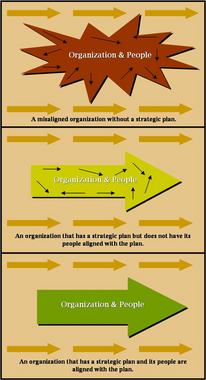Strategic Planning Puts Business On The Road To Success
With all the emphasis on change these days, why in the world would an organization want to create a five-year strategic plan? Ask most business people and they’ll concede that they can’t predict what will happen in the next quarter, let alone several years from now.
The fact is that a properly implemented plan, based on strategic thinking over the long term, is critical to the success of a business. A strong, written strategy with an action plan to accomplish it doesn’t guarantee success, but it’s much more difficult to be successful without one. Just as an individual is much more likely to succeed with established personal long-range goals and plans, so, too, is an organization more likely to survive and prosper with its own strategic plan.
Why is this true? Consider three different situations as illustrated on the chart at the bottom of this page. In the first example, you see an organization without a clearly articulated direction and the people within moving in many directions. There’s a complete lack of focus, and success comes only in spite of the situation, not because of it. This organization will have trouble getting out of its own way.
In the second frame, you see the organization with a strategic plan which points in a specific direction. Unfortunately, the organization’s members are still scattered and without a single target because they’re not aligned with the plan. This often happens when some organizations, petrified at the thought of their plan falling into the wrong hands, keep the plan a secret even from their own members, the very people who can ensure the success of the plan. Lack of alignment also occurs when the members of the organization haven’t played a part in the planning or haven’t been given the chance to buy into the plan and its contents.
In the third illustration, the organization and its members are aligned with the plan. Now the entire organization is poised to take advantage of the synergy of its members as they move forward.
There are other benefits to creating and following a strategy and action plan:
- The leadership tends to focus more on long-term issues – Individual decisions are evaluated based on their long-term implications and their consistency with the written plan.
- The organization begins to harness energy consistent with the direction – Creative energy of members can now kick in among those who accept ownership of and accountability for accomplishment of the goals contained in the plan.
- The plan itself creates enthusiasm – One client organization, upon completion of its mission statement, proudly recited the entire mission aloud at dinner during its annual retreat. The pride shown in ownership of that mission continues to this day, years after the fact. People tend to find ways to reach goals when they are clearly defined and when the organization’s leadership creates an expectation of success.
So, back to the original question: what’s the use of writing a three-year or five-year plan if you can’t predict changes in the business climate and other conditions over that time horizon? The answer is that it’s much better to have a plan from which you can deviate in response to changing economic, market and regulatory conditions. The alternative, flying without a plan, is dangerous to your organizational health.
